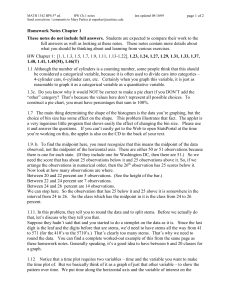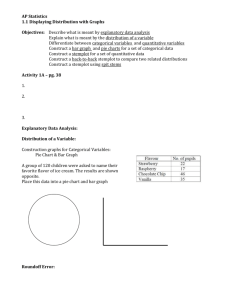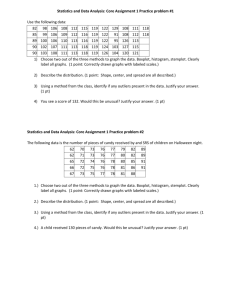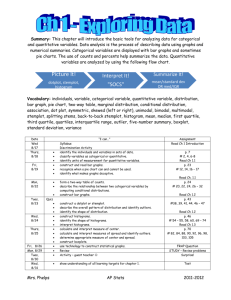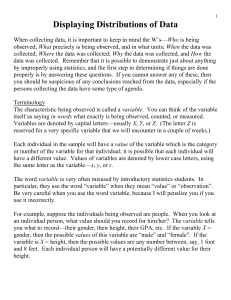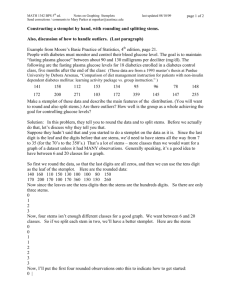Chapter 1
advertisement
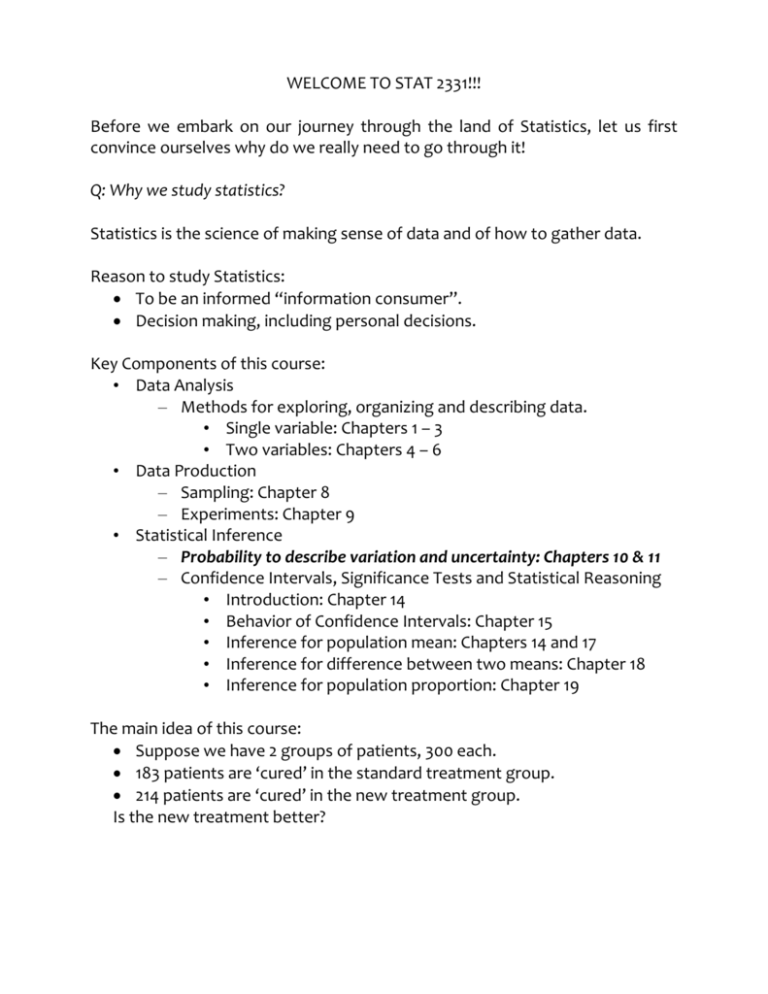
WELCOME TO STAT 2331!!! Before we embark on our journey through the land of Statistics, let us first convince ourselves why do we really need to go through it! Q: Why we study statistics? Statistics is the science of making sense of data and of how to gather data. Reason to study Statistics: To be an informed “information consumer”. Decision making, including personal decisions. Key Components of this course: • Data Analysis – Methods for exploring, organizing and describing data. • Single variable: Chapters 1 – 3 • Two variables: Chapters 4 – 6 • Data Production – Sampling: Chapter 8 – Experiments: Chapter 9 • Statistical Inference – Probability to describe variation and uncertainty: Chapters 10 & 11 – Confidence Intervals, Significance Tests and Statistical Reasoning • Introduction: Chapter 14 • Behavior of Confidence Intervals: Chapter 15 • Inference for population mean: Chapters 14 and 17 • Inference for difference between two means: Chapter 18 • Inference for population proportion: Chapter 19 The main idea of this course: Suppose we have 2 groups of patients, 300 each. 183 patients are ‘cured’ in the standard treatment group. 214 patients are ‘cured’ in the new treatment group. Is the new treatment better? Method of Generating Data Experiment: Active - Control which units get which treatments Sampling: Passive Anecdote: Haphazard Example: Is there a connection between olive oil consumption and avoiding cancer? Experiment: Two groups of rats, one gets olive oil, other doesn't. See which group has higher rate to get cancer. Sampling: Look at large group of people, randomly chosen from the population. Ask them about olive oil consumption and try to relate that to cancer. Anecdote: My friend's grandfather drank a pint of olive oil every morning and lived to 110!! Chapter 1: Picturing Distributions with Graphs Goal: Learn to examine a set of data. A data set consists of individuals characterized by variables. Individuals – objects being described by the data, e.g. Students in Stat2331 class Variables – characteristic of an individual. It varies from individual to individual, e.g. Height of student in Stat2331 class Different kinds of variables: a) categorical – usually not expressed as number, but as an adjective or category, e.g., Gender, race percentages make sense b) quantitative – expressed as number, e.g., Height, weight averaging makes sense Example: Fuel Economy of some 2009 model motor vehicles Make & Model Volkswagen Passat Ford Mustang Hummer H3 4WD Chevrolet Cobalt Vehicle Type Midsize Subcompact SUV Subcompact Transmission Automatic Manual Automatic Manual Number Cylinders 4 6 5 4 City MPG 19 16 14 24 Highway MPG 29 24 18 33 Q: What are the individuals in this data set? Q: Which variables are categorical? Quantitative? Distribution of a variable tells us what values the variable can take and how often it takes these values. Example: In last semester there were 60 Stat2331 students. Of those, suppose 18 had blue eyes, 36 had brown eyes and 6 had green eyes. What is the distribution of eye color for this class? Values: Frequency: Percent: Issue: How do we examine and describe the main features of a data set? We do exploratory data analysis. It involves examining each variable examining relationships between variables This is accomplished using 1) graphs 2) numerical summaries Graphing Distributions of Categorical Data Distribution of categorical data involves listing all possible levels or categories counting or obtaining percentages of individuals who fall into each category Two typical graphs used for categorical data are 1) Bar graphs 2) Pie Charts The main drawback of the pie chart is that you need to include all categories that make up a whole. That is, the percentages of all categories must sum to 100%. This is not required for a bar chart. Example: What type of graph(s) can be used to summarize the ethnic origins of the students in the statistics department? Ethnicity Caucasian Asian % 50 40 AfricanAmerican 6 Other Summary of the ethnic origins of the students in the statistics department African-American 6% Others 4% Caucasian 50% Asian 40% Example: The data summarized below are the % of females among people earning doctorates in 2003 in several fields of study. Computer science Life sciences Education Engineering Physical sciences Psychology 14.4% 39.9% 59.2% 9.6% 21.9% 61.2% What type of graph(s) can be used to summarize the data? Notes: (1)Bar-charts can be made by using counts or % but for pie-charts we need %s. (2) Keep gaps between the bars in a bar-chart. Pie Chart Computer science 7% Psychology 29% Life sciences 19% Physical sciences 11% Education 29% Engineering 5% Bar graph 70.00% 60.00% 50.00% 40.00% 30.00% 20.00% 10.00% 0.00% Computer science Life sciences Education Engineering Physical sciences Psychology Graphing Distributions of Quantitative Variables Two types of graphs are typically used for quantitative data. 1) Stemplots Work best for a small number of observations that are all greater than or equal to 0. To make a stemplot: a) **Sort the data.** Separate each observation into a leaf, which is the final digit, and the stem, which consists of the remaining digits. b) Write the stems in a column in consecutive order, with the smallest at the top, and draw a vertical line to the right of this column. c) Write each leaf in the row to the right of its stem, with the leaves in consecutive order, smallest to largest. Example: Initial blood pressure readings are taken for a group of subjects taking part in an experiment to see if calcium in the diet lowers blood pressure. Calcium Group 112 111 107 136 107 112 102 123 129 110 Placebo Group 117 123 112 110 112 109 114 98 119 102 130 The distribution of the calcium group using a stemplot looks like: Back-to-back stemplots are useful to compare two sets of data. Example: “Initial blood pressure readings”(contd.) When all the leaves would fall on just a few stems, we can split stems to double the number of stems. A stem that consists of data from 0 to 9 may be split into two stems: 0 to 4 and 5 to 9. Example: “Initial blood pressure readings”(contd.) 2) Histograms Useful for large data sets A histogram breaks up quantitative variables into intervals and displays the count or percentage of the observations that fall into each interval. Example: On a 20-pt. quiz, a section of 40 students had these scores: (Each class interval includes the right endpoint but not the left endpoint of the interval) Score Count Percent Exactly 0 0 0% 0-5 3 3/40=7.5% 5-10 5 5/40=12.5% 10-15 12 30% 15-20 20 50% Total 40 100% Histogram 25 Frequency 20 15 10 5 0 0 2.5 7.5 12.5 17.5 Notes: (1)Histograms look like bar charts without the gaps between bars. (2) If frequencies (same as counts) are used and the intervals are all of the same width, then the sum of the heights of the bars must equal the total number of observations. (3) If %s are used, then the sum of the %s of all the bars must equal 100%. Comparison of histogram and stemplot Histograms do not display the actual observed values while stemplot do. You can reconstruct the original data set from a stemplot. Describing Distributions Overall pattern of a distribution is described by its 0.0 0.1 y 0.2 0.3 0.4 (1) shape a) symmetry symmetric - area to the left and right of the midpoint of the distribution are mirror images of each other. -3 -2 -1 0 x 1 2 3 0.0 0.0 0.05 0.05 0.10 0.10 y y 0.15 0.15 0.20 0.20 0.25 0.25 skewed - area is concentrated on one side and there is long tail on the other side. 0 0 2 4 6 8 2 4 6 8 10 10 x x Right-skewed distribution Left-skewed distribution 0.3 yy 0.2 0.2 -3 -2 -1 0 1 2 3 0.0 0.0 0.1 0.1 y 0.3 0.4 0.4 b) # of modes (most frequent observation) or peaks of the distribution e.g. unimodal (one peak) or bimodal (two peaks) x -2 0 2 4 6 xx Unimodal distribution (2) Bimodal distribution center - midpoint of the distribution (3) spread - range (smallest and largest values) of the distribution Deviation from the overall pattern outliers - values that are far from the bulk of data. Example: Draw a histogram of the starting salaries (in $1000’s) of last year’s graduating students of SMU. Salary % 15-25 14 25-35 47 35-45 26 45-55 8 55-65 3 65-75 1 75-85 1 Use the histogram to answer the following questions: Percentage Histogram 50 45 40 35 30 25 20 15 10 5 0 20 30 40 50 60 70 80 Q: Describe the shape of the distribution? Q: What is the range of the salaries in this data set? Q: Where do most of the salaries seem to be centered? Q: What percentage of students had starting salaries between $25,000 and $45,000? Q. In which class interval does the third quartile lie?
